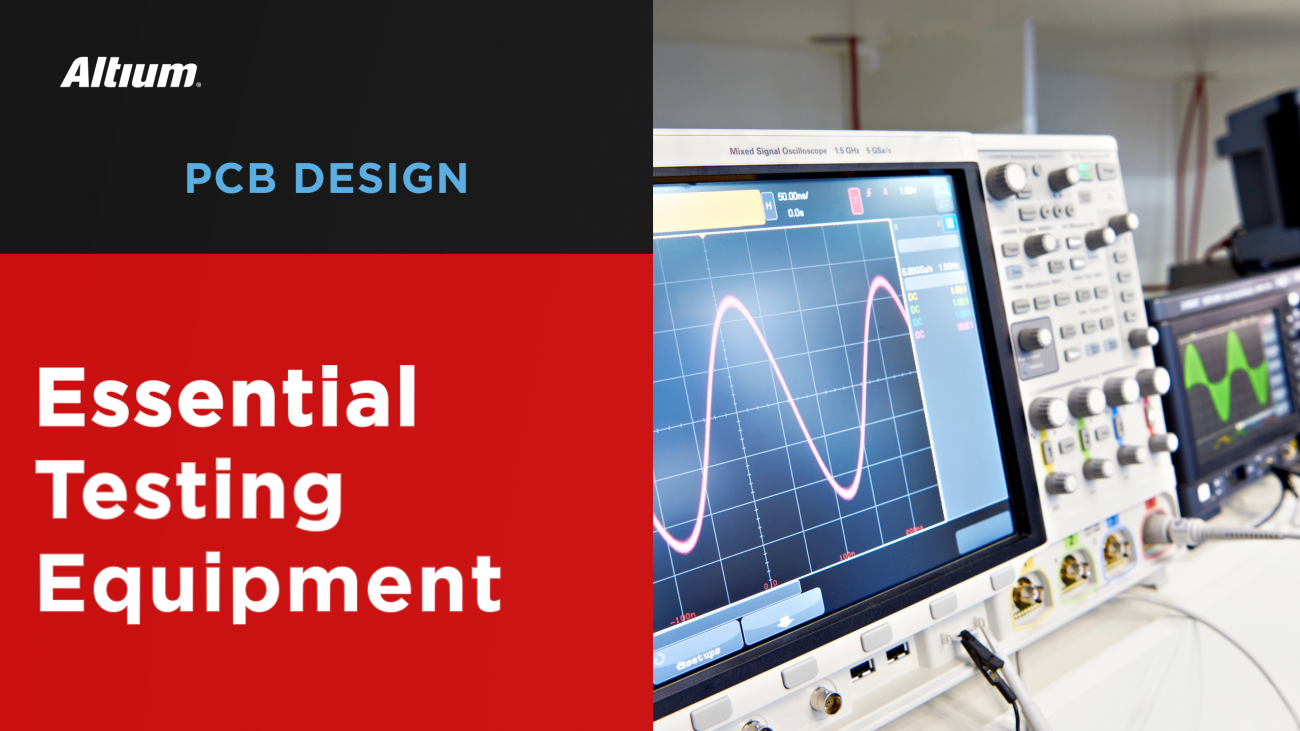Beginner’s Essential Equipment for PCB Testing

When you’re just getting started on your adventures in PCB design, you’ll eventually need to test your prototype boards. Prototyping and testing are very important tasks for any designer, but you need to have the right set of equipment to ensure you can get accurate results.
In this article, I’ll go over some of the basic test equipment that new engineers should have in order to test and debug their prototype boards. We’re not talking about building a large company lab here, we’re more worried about giving you the basic capabilities you need to test and verify your first projects. If you’re creative and you make use of online retailers, you can probably find everything in this list for about $600. This will give you the basic capabilities you’ll need to get started so that you can build your testing skills and equipment over time.
New Engineer’s Shopping List
Multimeter With Multiple Probes
A basic multimeter is the mainstay of any engineer who needs to probe and test a PCB prototype. There are plenty of basic multimeter options that provide all the standard measurements and ranges with high precision. Some will also allow for temperature measurements with a special probe.
Your multimeter should provide different options for probes, including very fine tip probes that allow probing of very small components. Tapping a probe to a 0402 or 0201 component can be very difficult with large probes, so it pays to buy an extra set of very fine-tipped probes for your multimeter.

USB to Serial Bridge
For the embedded crowd, a developer will need to communicate commands to a chip on a PCB, and the simplest way to do this is with a USB to serial bridge. These devices plug into a USB port and allow you to send commands to a remote device via the USB connection. The interface is usually UART/USART, and commands can be sent over PuTTy or TeraTerm. These are sometimes based around a simple FTDI chip; you can also follow the example shown in this recent Altium Designer project from Zach Peterson.

Programmer
If you’re developing with a vendor’s IDE, then you will need a vendor tool to flash and program the processor on your board. This can be done with a vendor programming tool. Not all vendors create these tools, but there are 3rd party modules that can plug into your design, and you will use software to push a binary onto the end device.
For example, Microchip has developed their MPLAB module and software for programming applications onto PIC microcontrollers. Another popular tool is the PRESTO programmer from ASIX, which supports a huge list of microcontrollers and flash memories.

Soldering Iron and Wire
Basic soldering kits and thin-gauge wire are a must-have for testing and debugging. It’s very common that you’ll need to solder a small wire, remove a component, or swap a component during testing. Get yourself a low-cost soldering kit with temperature control and multiple tips. You should also get some solder wire, solder paste, and a braided wire so you can perform rework, even with small SMDs. Having multiple tips is also very important for applying heat in tight spaces and to very small pads.

Basic Oscilloscope
Oscilloscopes can be very expensive, especially when they need to have very sample rate, bandwidth, and built in analysis capabilities. For beginner designers, or for a small lab that is just used for power-up testing, it’s a good idea to have a low-cost, basic digital oscilloscope for taking common measurements.
Here when we say “basic”, we really do mean that a low-cost scope will be fine for many tasks. The point is to detect whether the AC signal is present in certain areas of a circuit, such as being able to detect whether a circuit with feedback is oscillating. This is widely applicable in many circuits in a design, such as power regulators and amplifier circuits. A low-cost scope (about $300-$500) for these basic measurements up to ~100 MHz is a great way to round out your first set of testing equipment.

Make sure your scope probe has two attenuation options (1x and 10x) so that you can sense different outputs. Also make sure your probe has higher bandwidth than your scope!
Current Limiting DC Power Supply
Last but not least, we can’t forget about a power supply. A small benchtop regulated power supply is a must-have for any electronics engineer. For most boards, you will just need a basic DC power supply that provides reasonable voltage and current output.
You can find 100-200 W low-noise power supplies that output up to reasonably high voltages and moderate currents (up to 5 A) for around $100 on Amazon or eBay. Make sure to get a bench supply with some basic features like ON/OFF toggle and current limiting, the latter of which is very important for short circuit or low-load protection.

As your projects and skill level grow, so will your necessary test equipment needs. Eventually, you might need to graduate to a set of more specialized equipment to test your prototypes. This could include:
- Higher frequency oscilloscope
- DC electronic load
- LCR meter
- Spectrum analyzer
- Logic analyzer
- Low-frequency vector network analyzer
- Microscope for hand soldering small parts
Also make sure to check out this article from Mark Harris, it contains a longer list of materials and tools you’ll need to build up your lab.
Whenever you need to test your board, you can easily cross-probe between the schematics and your PCB within the unified design environment of in Altium Designer®. To implement collaboration in today’s cross-disciplinary environment, innovative companies are using the Altium 365™ platform to easily share design data and put projects into manufacturing.
We have only scratched the surface of what’s possible with Altium Designer on Altium 365. Start your free trial of Altium Designer + Altium 365 today.


















